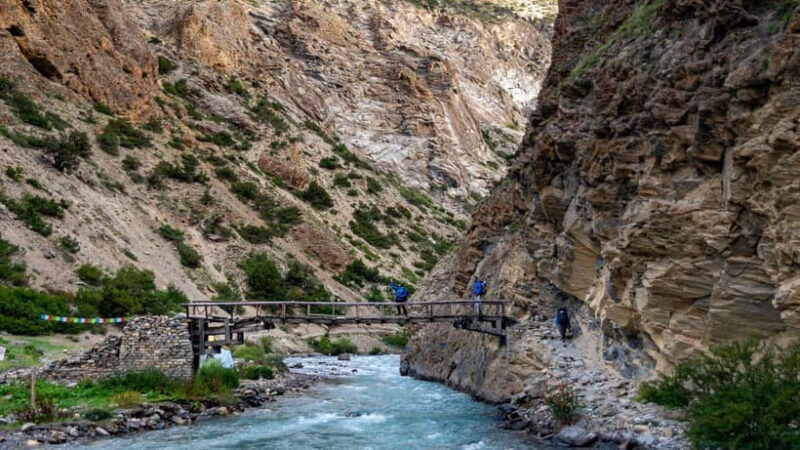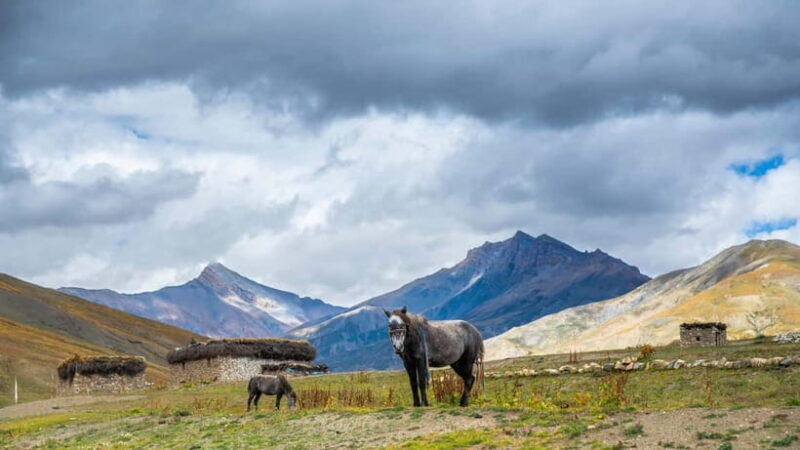Location: Karnali Zone, Nepal
Country: Nepal
Price: $2,300 per person
Supplier: Hakuna Matata Trekking Nepal Pvt. Ltd
What makes the Upper Dolpa Cultural Trek stand out?

This trek is not your average Himalayan hike. For $2,300, you’re booking a challenging, full-board camping adventure that takes you through some of Nepal’s most untouched landscapes and into the heart of Tibetan-influenced culture.
What we love about this experience is how it combines spectacular mountain vistas with authentic cultural encounters. Imagine walking through centuries-old monasteries like Shey Gumba, or crossing high passes above 5000 meters—these are the moments that stick with you long after the trek ends. Plus, you’ll get a chance to support local education initiatives, adding a feel-good element to your journey.
A key consideration is that this trek is not for the faint-hearted. With its high altitudes, remote locations, and rugged terrain, it demands a good level of fitness and acclimatization.
This trek is best suited for adventurous travelers seeking an off-the-beaten-path experience, those eager to explore Tibet’s cultural echoes in Nepal and willing to endure some physical challenges for truly authentic rewards.
You can check availability for your dates here:Key Points

- Remote and untouched: You’ll explore one of Nepal’s most isolated regions, far from tourist crowds.
- Cultural richness: Visit ancient monasteries and villages with Tibetan-influenced traditions.
- High-altitude passes: Cross three mountain passes above 5000m, with breathtaking views.
- Natural beauty: Expect stunning vistas of peaks like Dhaulagiri, Putha Hiunchuli, and Churen Himal.
- Wildlife spotting: Keep an eye out for snow leopards, blue sheep, and Himalayan birds.
- Support local communities: Your trek helps fund education for children in Upper Dolpo.
A Detailed Look at the Trek Itinerary and Highlights

Starting the Journey: From Kathmandu to Dunai
Your adventure begins with a scenic flight from Kathmandu to Nepalgunj, offering a taste of the Himalayan landscape from above. Once in Nepalgunj, you’ll take a domestic flight to Dunai, the gateway to Upper Dolpo. Traveling by air is essential here—overland routes are too rugged and time-consuming—so expect an early start and a bit of anticipation for the remote landscapes ahead.
Trekking Through Remote Villages and Forests
From Dunai, the trail leads you through lush forests and grazing pastures. Walking through these areas, you’ll notice how traditional lifestyles persist amid spectacular scenery. You may encounter yak herders, local farmers, and children waving from afar. “The scenery is breathtaking—forest-covered hills suddenly open up to vast mountain ranges,” one reviewer notes. The route is designed to reveal the contrasts between lush greenery and stark, rocky landscapes.
More Great Tours NearbyThe Cultural Gems: Shey Gumba and Yangjer Gumba
A highlight of the journey is the visit to centuries-old monasteries like Shey Gumba and Yangjer Gumba. These sacred sites are more than relics—they’re living centers of spiritual practice. We loved the way guides explained the significance of these monasteries, giving us insight into Tibetan Buddhist traditions that have been preserved here for generations.
Crossing High Mountain Passes
A major challenge and thrill of this trek are the high passes. Expect to cross Jyangla Pass (5,221m), Shey La (5,000m), and Kang La (5,350m). These stretches demand both physical endurance and mental toughness. The views from these passes are jaw-dropping, revealing vast panoramas of peaks like Putha Hiunchuli and Churen Himal.
One reviewer mentions, “The high passes are tough, but the panoramic views make every step worth it.” Be prepared for cold, wind, and altitude symptoms—proper acclimatization and pacing are key.
Cultural Encounters in Saldang and Nyisal
Walking through villages like Saldang and Nyisal offers a deep cultural experience. These villages are where you see Tibetan influence woven into daily life—traditional dress, prayer flags, and local customs. In Nyisal, there’s an opportunity to participate in a cultural show with the local community, making the experience even more personal.
The Finale: Phoksundo Lake and the Bon Monasteries
The trek culminates at Phoksundo Lake, one of Nepal’s most stunning natural wonders. Its turquoise waters are framed by snow-capped peaks, creating a scene that feels almost surreal. The area is also home to ancient Bon monasteries, offering a final spiritual reflection after days of adventure.
We loved the peacefulness here, a perfect spot for rest and contemplation. Many reviews highlight how this tranquil lake provides a fitting end to such an intense journey.
Practical Details and Considerations

Logistics & Inclusions
The experience includes all trekking permits and necessary documents, local tent shelters for overnight stays, and an experienced guide who’s well-versed in the region’s terrain and culture. Your contribution also supports education initiatives for children in Upper Dolpo, adding a meaningful dimension to your journey.
What’s Not Included?
Cost considerations include international flights, visas, travel insurance, and personal expenses like meals, laundry, and souvenirs. It’s important to budget for these extras, especially since the trek itself is full-board and camping-based—meaning you’ll be responsible for personal gear and some additional logistics.
Preparing for the Trek
Expect cold weather, especially at higher altitudes, so packing warm clothing, thermal layers, a good sleeping bag, and rain gear is essential. Trekking shoes should be sturdy and broken-in, and don’t forget goggles and sun protection for the high passes.
Group Size and Flexibility
While not explicitly detailed, such remote treks usually operate with small groups, which enhances the personal experience but requires flexibility in case of delays or weather-related issues. The option to reserve and pay later provides some flexibility if your plans are tentative.
When to Go & Duration
The tour is designed for a multi-day trek, with the full itinerary likely spanning around two weeks, considering travel days and acclimatization. Weather windows are typically more stable in spring and autumn, offering clearer skies and milder temperatures.
Authentic Experiences and What Travelers Say
Many who have undertaken this trek emphasize the knowledgeable guides and stunning vistas as the most memorable aspects. One reviewer comments, “Our guide was incredibly insightful about the local culture and history, which added depth to every visit.” Another fondly recalls, “The views from the passes are some of the most spectacular I’ve ever seen, worth every ache.”
The cultural interactions, especially during the village visits and monastery explorations, are often highlighted as heartfelt and genuine, not just tourist stops.
Final Thoughts: Who Should Consider This Trek?

This journey is ideal for adventurers with a taste for authentic, off-the-beaten-path travel. If you’re comfortable with high altitudes, rugged terrain, and long days of walking, you’ll find this trek rewarding beyond measure. It’s perfect for those wanting more than just a scenic hike—this is about cultural discovery, spiritual reflection, and challenging oneself physically.
While the price is higher than typical treks, the full-board camping, expert guides, and support for local communities offer good value. The experience delivers unrivaled access to some of Nepal’s most remote and pristine environments, making it a once-in-a-lifetime adventure for dedicated explorers.
Frequently Asked Questions
Is this trek suitable for beginners?
This trek is quite challenging due to the high passes and remote location. It’s best suited for experienced trekkers with good fitness and some altitude trekking experience.
What kind of accommodation is provided?
You’ll stay in local tent shelters, which means sleeping outdoors but in designated camping areas. It’s a full-board setup, so all meals are included.
Are permits included?
Yes, the trek includes all necessary permits and documents needed for the journey.
Can I join this trek with a small group?
While group size isn’t specified, such treks typically operate with small groups, offering a more personalized experience.
What should I pack?
Bring warm clothing, rain gear, sturdy hiking shoes, a sleeping bag, thermal layers, goggles, and weather-appropriate trekking gear.
Does the trek support local communities?
Yes, your participation contributes to supporting children’s education in the Upper Dolpo region through Himalayan Development Initiative.
How physically demanding is the trek?
Expect high-altitude crossings and long days, so good physical fitness and acclimatization are important.
When is the best time to go?
Spring and autumn generally offer the best weather and clearer skies, though specific dates should be checked with the provider.
What is included in the price?
The price covers permits, local camping accommodations, guided support, and a contribution to local development. International flights, visas, personal expenses, and insurance are not included.
In The Sum Up
The Upper Dolpa Cultural Trek offers a rare chance to step into one of Nepal’s most isolated and culturally rich regions. It rewards those who are ready to face high passes, unpredictable weather, and the physical demands of a remote Himalayan trek. If you’re seeking an adventure that combines spectacular scenery, authentic Tibetan-inspired culture, and meaningful community support, this journey is hard to beat.
It’s a trek designed for those who want to push their limits and connect with a part of Nepal few travelers ever see. The stunning landscapes, ancient monasteries, and genuine cultural exchanges make it a truly special experience—one that’s worth every challenging step.
You can check availability for your dates here: